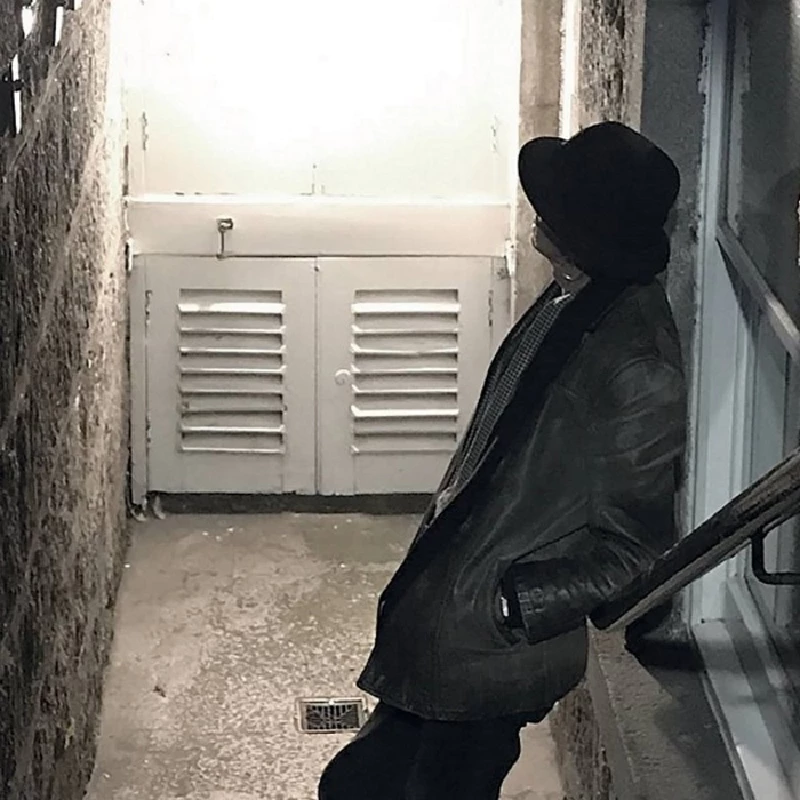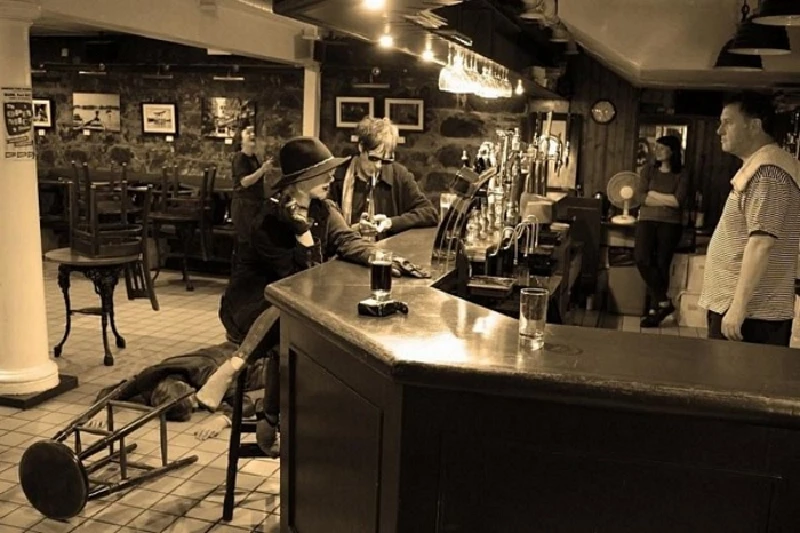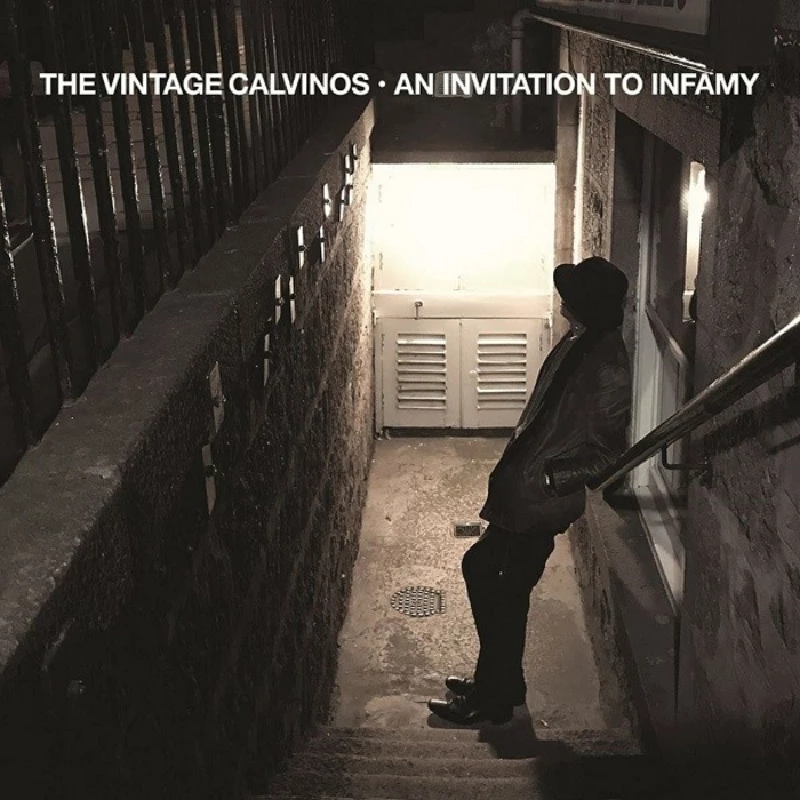Vintage Calvinos - Interview
by John Clarkson
published: 23 / 12 / 2017

intro
John Clarkson speaks to Aberdeen-based based bass player and vocalist David Baird about his orchestral pop project the Vintage Calvinos whose just released debut album 'An Invitation to Infamy'involves over twenty other musicians.
The Vintage Calvinos have released one of the most ambitious records of the year with their debut album, ‘An Invitation to Infamy’. A symphonic and sweeping pop record, it is the project of Aberdeen-based bassist and vocalist David Baird, who was previously the bassist and main songwriter in a short-lived late 70’s/early 80’s local band the Squibs that released two singles and won the patronage of John Peel. Baird also played for a while in Vibrators’ frontman Knox’s band in London before returning to Scotland. ‘An Invitation to Infamy’ is a prime example of what can be achieved on a tiny budget, and with resourcefulness, creativity and enthusiasm. It involves, as well as Baird, a rotating cast of twenty other musicians including guitarists, keyboardists, strings players, percussionists, trumpet, trombone, tuba and sax players, backing singers and on one song ‘So Many People’ also a brass band. From the strings-drenched ‘Eleanor Rigby’-style ‘Prelude’ and its first full song, the stomping orchestral glam rock ‘Last Tango’ (about a brief but passionately played-out romance) onwards, its scope is simply astonishing. The musicians on ‘An Invitation to Infamy’ include Iona Macdonald, the singer with acclaimed folk duo Doghouse Roses; Jeremy Thoms, the front man and guitarist with Edinburgh-based alternative rock outfit the Cathode Ray who also produced the album, and jazz session player Fraser Peterkin. “It is essentially a pop album, “David Baird says to Pennyblackmusic in an interview about ‘An Invitation to Infamy’. “But I wanted a diversity of musicians with different backgrounds in order to give each of the songs a different flavour. If I had simply used a four piece made up of rock musicians, it would have ended up sounding pretty samey.” “All those involved in the making of ‘Infamy’ are involved with their own bands. Some of the musicians I already knew. Others I approached specifically as I liked their playing, such, as, for example, Fraser Peterkin, who is a much in-demand musician in jazz circles. I wanted musicians with disparate backgrounds and approaches. Iona has a folk background. Others had a classical background.” “The album was all planned out in advance,” he adds. “There wasn't any improvisation. I wrote the songs, then went into the studio with Paul Davidson who plays guitar and keyboards on ‘Infamy’ and was the album’s engineer and we recorded a guide track for each of them. I knew how the songs had to be arranged, and we would then get the musicians in and give them their parts to play. It took around two years to make as there were studio problems and arranging sessions was sometimes problematic. None of the musicians involved, however, would accept payment. A couple of drinks and that was it. The expense was studio time which did add up.” ‘An Invitation to Infamy’ was released on Jeremy Thoms’ label Stereogram Recordings (The Cathode Ray, the Band of Holy Joy, Roy Moller. James King & The Lonewolves, the Eastern Swell). Thoms, like Baird, is originally from Aberdeen, but moved South to Edinburgh over thirty years ago. “I've known Jeremy a long time,” says David Baird about Thoms, who as well as producing ‘An Invitation to Infamy’ also mixed and mastered it. “And when I told him what I was up to, he immediately suggested I come on board with Stereogram. My God, you should hear the discussions we have had about music over the years. We are both devoted to it. I've always thought he has a pretty good ear, so when it came to who was going to produce ‘Infamy’ I thought he was the obvious choice. It was a fairly elongated process and he would send me a mix, and then there would be numerous texts back and forth, and then he would send me another mix. Then he got down to producing it and the same process continued. We were at no point in the same room together but I saw that as an advantage.” One of the central tracks on ‘An Invitation to Infamy’ is ‘This Handsome Boy’, a sweltering nearly six -minute soul anthem that throws together sharp peals of brass with swirling strings. It tells of its title character who becomes involved with a girl, a boy and "a very pretty saint" who each introduce him to and show him their "room of a thousand dreams", but he decides instead that he needs to be "free" of all of them. The chorus line as the instruments surge to a high is “lightning only strikes twice when there is thunder in the air.” “It's about a boy who has these individuals who are obsessed with him,” explains Baird. “But he has no need for them although he likes them. They would stifle him. The thunder and lightning chorus symbolises that things build up over a period and then explode. They become very demanding and that is when the lightning strikes, but the thunder has been there from the moment they show him their rooms.” ‘Alice’ in contrast is a hazy, softly psychedelic number which tells of a young boy’s loss of virginity to a more experienced older girl, who in the song’s final verse turns out to be his sister. Surprisingly it takes its inspiration from Luchino Visconti’s 1971 art house film ‘Death in Venice’, which adapted from German writer Thomas Mann’s 1912 novel, tells of an aging homosexual composer played by Dirk Bogarde who becomes fixated with a teenage boy who walks with his family each day on the same beach that he does. “With ‘Alice’, I wanted to write about first love or sexual awakening, but there are so many songs which cover that so it needed a twist,” Baird says. “There is, of course, no incest in ‘Death in Venice’, simply an old man's obsession with a young boy. The boy and his family, however, daily parade on the beach just outside Venice, and I thought what if the boy and his older sister had this thing going on, and then I imagined an entirely different set up whereby the beach was deserted and they were on their own.” Near the end of ‘An Invitation to Infamy’ is ‘Rock Dreams Part 2’. It is a breezy and brassy rock and roll number about a music-obsessed young man who dreams up a series of encounters hanging out with Elvis, 60’s era the Rolling Stones, David Bowie and Iggy Pop, and Lou Reed and Andy Warhol during their Factory years, and who at the end of the song abandons his dull home town looking for something better and more exciting. Despite his years spent in London, Baird denies the song is about himself. “It isn't autobiographical,” he says simply. “I wrote the last verse about the guy leaving town to contrast it with the previous verses and to allow Elvis, Mick and Andy to become his old friends.” David Baird’s problem is now that ‘An Invitation to Infamy’ is out working out ways of promoting it. “There are no immediate plans to play live,” he reflects. “But it's a vague possibility and would doubtless involve quite a different line-up from those who participated in the making of ‘Infamy’”. “In terms of getting the album promoted, it requires radio play, coverage in the press, internet and word of mouth,” he says in conclusion. “It is notoriously difficult these days anyway for an independent record to get access to radio and media.” Hopefully‘An Invitation to Infamy’ will win itself an audience. It is an album that deserves to be heard.
Band Links:-
https://www.facebook.com/thevintagecalvinos/Picture Gallery:-


most viewed articles
current edition
Carl Ewens - David Bowie 1964 to 1982 On Track: Every Album, Every SongArmory Show - Interview with Richard Jobson
Colin Blunstone - Thalia Hall, Chicago, 16/7/2025
Bathers - Photoscapes 1
Visor Fest - Valencia, Spain, 26/9/2025...27/9/2025
John McKay - Interview
Billie Eilish - O2 Arena, London, 10/7/2025
Robert Forster - Interview
Loft - Interview
Sir Tim Rice - Interview
previous editions
Heavenly - P.U.N.K. Girl EPManic Street Preachers - (Gig of a Lifetime) Millennium Stadium, Cardiff, December 1999
Beautiful South - Ten Songs That Made Me Love...
Pixies - Ten Songs That Made Me Love...
Oasis - Oasis, Earl's Court, London, 1995
Paul Clerehugh - Interview
Trudie Myerscough-Harris - Interview
Doris Brendel - Interview
Prolapse - Interview
Peter Perrett - In Dreams Begin Responsibilities Interview Part One
most viewed reviews
current edition
Phew, Erika Kobayashi,, Dieter Moebius - Radium GirlsAmy Macdonald - Is This What You've Been Waiting For?
Sick Man of Europe - The Sick Man of Europe
Davey Woodward - Mumbo in the Jumbo
Cynthia Erivo - I Forgive You
Lucy Spraggan - Other Sides of the Moon
Bush - I Beat Loneliness
Alice Cooper - The Revenge of Alice Cooper
Blueboy - 2
Suzanne Vega - Flying With Angels
Pennyblackmusic Regular Contributors
Adrian Janes
Amanda J. Window
Andrew Twambley
Anthony Dhanendran
Benjamin Howarth
Cila Warncke
Daniel Cressey
Darren Aston
Dastardly
Dave Goodwin
Denzil Watson
Dominic B. Simpson
Eoghan Lyng
Fiona Hutchings
Harry Sherriff
Helen Tipping
Jamie Rowland
John Clarkson
Julie Cruickshank
Kimberly Bright
Lisa Torem
Maarten Schiethart